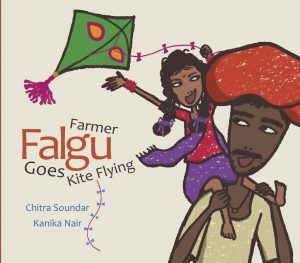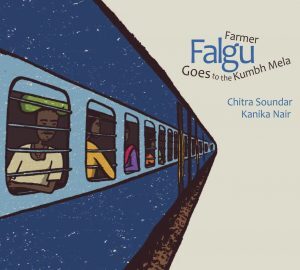Chitra Soundar's Blog, page 3
December 13, 2019
Living up to my promise and hope…
This election has created a blanket of despair. But I’m hoping to shake it off and bring hope and promise to every young child I meet – they’re not only going to determine their own lives, but of the planet and so many of the downtrodden too.
Here is my response to the election result the only way I know.
[image error]
April 7, 2019
Story Starter – Workshop Resources

Are you a teacher or a writer or a storyteller? Then you would definitely enjoy this post on StoryStarters that started as a simple question on Twitter. And then the thread unravelled into a yarn of wonderful possibilities.
Based on the story starters, here are some storytelling / creative writing / imagination activities. They are not for anyone specific – from classrooms to lecture halls, from a studio to a lonely cafe, they can be used anywhere.
Click here to download.
STORY STARTERS…
A Twitter thread that unravelled….
As always I daydream as much as I dream during the night. I was thinking about stories and how they started in Tamil. Here is a beautiful representation in popular culture from a Tamil movie.
And in response, people from across the world told me how stories start in their own cultures and languages including popular culture.
Teachers, storytellers and writers across the world got excited by this flurry of wonderful phrases that triggered our imaginations and set us off into a new journey.
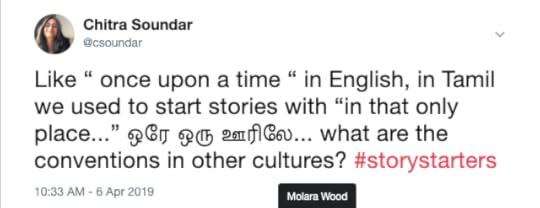
So here I gathered all the bits of the thread as much as possible for all you story geeks to use.
Read the Caution! before you use it.
Also if you want similar story resources to use
in your classrooms, get in touch!
Click here to view it online.
Click here to download from Google Drive.
March 25, 2019
For Some or All?
I write mainly stories that touch upon India in some way. Putting aside why that’s so, my stories bring tales from all parts of India.
 Illustrated by Kanika Nair, Farmer Falgu series are great stories about positive thinking and making the most out of difficult situations.
Illustrated by Kanika Nair, Farmer Falgu series are great stories about positive thinking and making the most out of difficult situations. 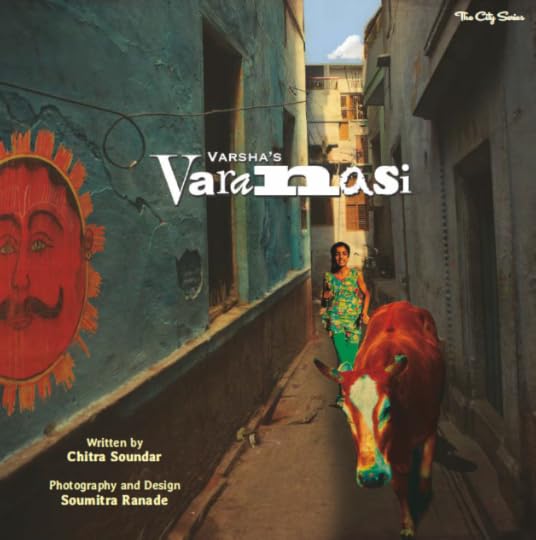 Varsha’s Varanasi introduces the beautiful city of Varanasi.
Varsha’s Varanasi introduces the beautiful city of Varanasi. 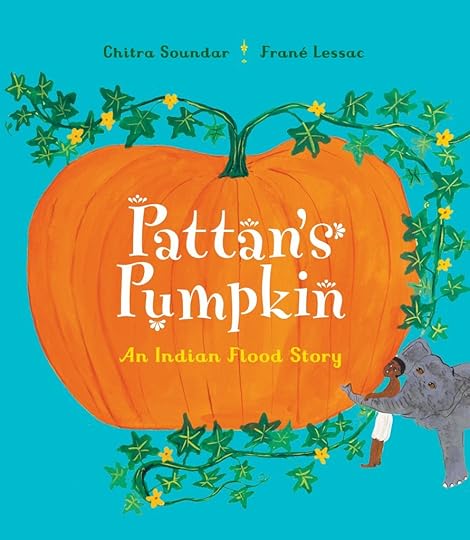 Pattan’s Pumpkin brings a previously untold story of the Irular tribe. Illustrated by Frané Lessac
Pattan’s Pumpkin brings a previously untold story of the Irular tribe. Illustrated by Frané Lessac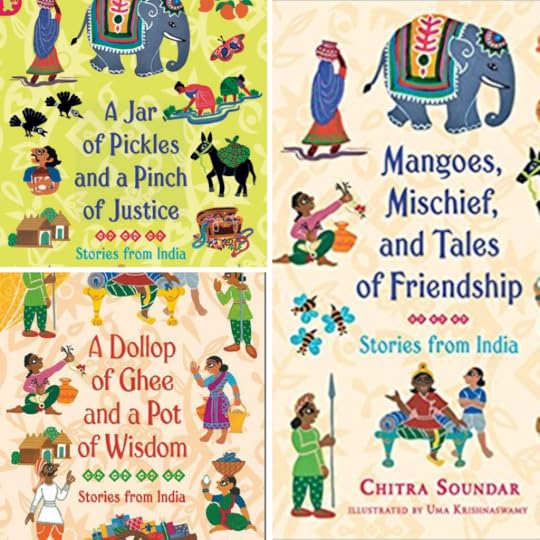 Prince Veera stories reimagine ancient trickster tales from India. Illustrated by Uma Krishnaswamy
Prince Veera stories reimagine ancient trickster tales from India. Illustrated by Uma KrishnaswamyThese stories are definitely for the Indians who live everywhere in the world. I witness the joy of children from Indian backgrounds in schools across the world when I bring these stories to them. They are undoubtedly a joy to the parents and grandparents who can relate to them and enrich the reading session with their own stories and tales from their own lives.
But is that all? Surely these stories appeal to everyone else? For a child who has no connections to India, these stories are exotic, magical and from a place where they had never been to. Perhaps they’d travel to India, inspired by these books. Perhaps they’d relate to their neighbour from India better.
Stories about someone other than our lived experience is a window to the outside world. It is a door to walk through and make friends, shake hands and embrace someone new. It’s a mirror that reflects how similar we are to others in this world, however far we seem.
“When the only images children see are white ones…as
long as children are brought up on gentle doses of racism
through their books… there seems to be little chance of
developing the humility so urgently needed for world
cooperation.”
-Nancy Larrick, 1965
 Sliding Doors for all…
Sliding Doors for all…Schools, libraries, parents, grandparents, booksellers, publishers and reviewers must therefore not brand these books as “Great for South Asian Kids”. Because they are universal in their appeal – both to South Asians and to the rest of the world. How else will a child find out about life outside their town, city and country?
Read about why we need public libraries and these must be curated by professionals who understand Equity in the Library.
Schools, libraries, parents, grandparents, booksellers, publishers and reviewers must not only embrace if they want diversity in their reading – but also if they don’t want it. What if your community or school or customer base is monochrome? Then how would you show your world that the universe is a bigger place than what they can see and perceive?
Absolutely make it available in communities where South Asian readers live. But don’t forget it to bring it to readers who have not ventured beyond safe reading choices.
As the fabulous John Burningham once said,
"Children are not less intelligent, they’re just less experienced."
So let’s give our children a varied, rich and wide experience of things around the world. So they grow up to be citizens of the world embracing people from all backgrounds.
Elli Woollard wrote a poem to go with this post and she has given me permission to reproduce it here.
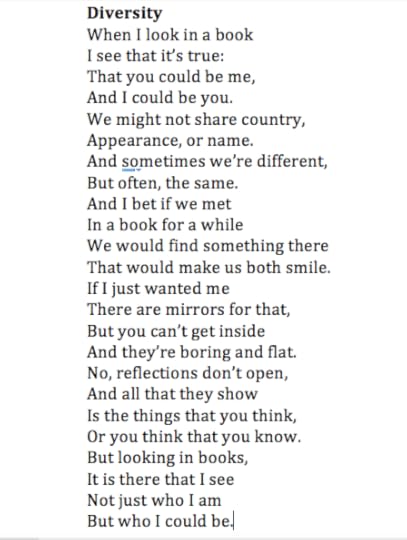 Diversity by Elli Woolard
Diversity by Elli WoolardMarch 23, 2019
Fantastic News!
Have you heard? We are celebrating!
Poonam Mistry, the illustrator of this gorgeous picture book published by Lantana Publishing, has been shortlisted for the Kate Greenaway Medal.
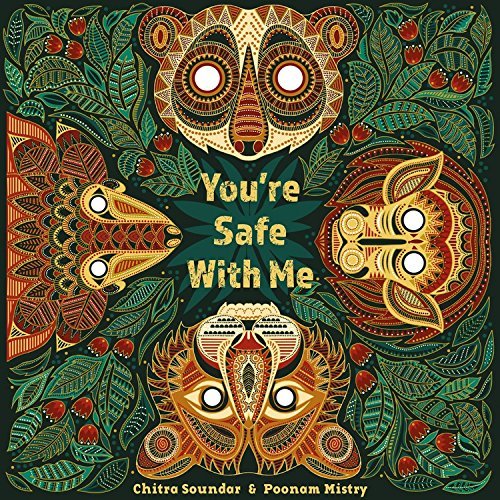
This is her first children’s book and what a remarkable achievement. Congratulations!
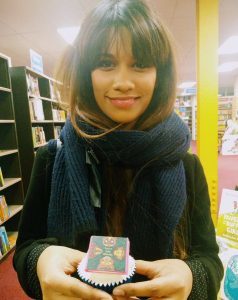 Poonam Mistry at the Shortlist announcement
Poonam Mistry at the Shortlist announcementIf you’re shadowing the Kate Greenaway judges or inspired to pick up this book and read, then here are some wonderful resources to add to your experience.
Read Poonam’s interview about her art here.
Get colouring sheets (created by Poonam), puzzles and word searches here.
And if you’re no longer scared of thunderstorms and want to read more about them, find two poems about thunderstorms here.
Are you a teacher? Here are some wonderful classroom resources created by the publishers Lantana Publishing.
So what are you waiting for? Get the book and start reading!
March 16, 2019
MAKE WRITING FUN IN SCHOOLS – PART 3/3
In the first part of this series of blog posts, I talked about how to introduce creative writing in schools in a fun way. Then in the second part I talked about why it’s important to build an imagination muscle and flex it regularly.
In this final part, we will look at how to practice all these ideas in a busy and often assessment filled curriculum. Children will love reading and writing if there is much more of a self-invested motivation. So these are some ideas for both teachers to practice and practice in their classrooms with students.
Practice What You Preach
a) Start (or end) every day / lesson with a related prompt and a writing activity. Whether you’re going to be discussing mountains in a lesson about landforms or about adjectives in an English lesson, you can start with a poem or a story prompt related to the lesson. Get them to write a simple 4-line poem or a 6-line story about an adventure over a mountain using the terms they would have learnt in the previous session.
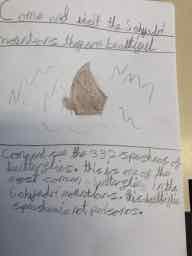
It’s a great way to revise and apply, improve comprehension because the concepts you taught have to be understood to be thrown and mixed into a story.
b) Start a writing journal – the teacher, the TAs and the students could keep a writing journal where they could write a few lines every day in one of the classes (and draw) to comment on, discuss, share their thoughts on the day or the lessons or their break-time. Whether you are an adult or a child, professional or an amateur writer, a topic or theme or a prompt would help initiate the writing process so they are not staring at a blank page.
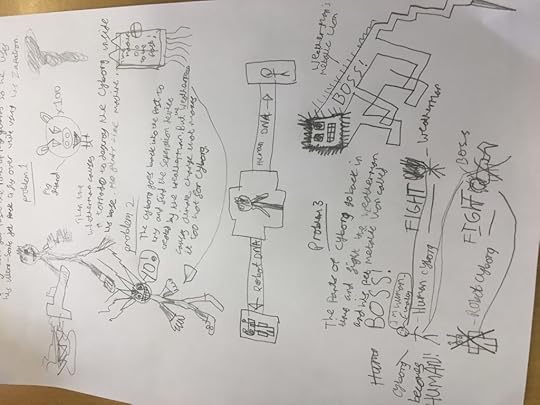
c) Start class or school assemblies with word prompts – if the entire school is buzzing about a word – for example – umbrella – every child’s story would be different yet would have been triggered by the word umbrella.
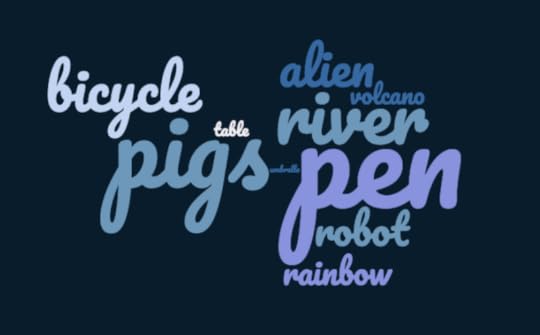
d) Collaborative writing and drawing is a brilliant way to reduce the amount of writing each child has to bear and a great way to promote collaborative working within groups. Discuss stories, get children to work in groups to create a book, draw a cover, do the blurb, get inside writing and illustrations. It’s important that teachers take an active part in these activities to bring a sense of “we’re all in it together.”
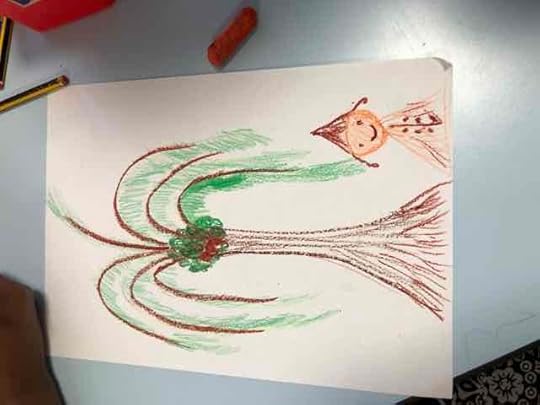 A teacher’s drawing
A teacher’s drawing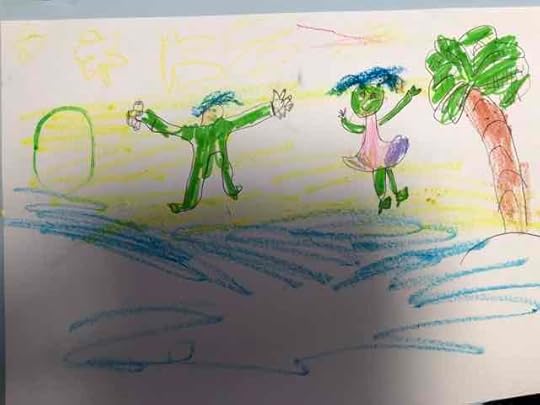 A child’s drawing of the same scene
A child’s drawing of the same scenee) Display teachers’ and children’s work alongside in classroom and school displays. Choose a topic and let everyone write a story or a poem or draw and pin it up. Be brave – the less children stress about sharing their work, less pressure to write. It increases joy and reduces the fear of criticism. And teachers should lead the way by displaying their work.
January 30, 2019
Make Writing Fun in Schools – Part 2/3
In 2018 alone, I’ve done over 200 workshops in schools across the UK and US. Often teachers ask me how to interest children in writing – without them groaning and moaning, whining and whinging.
As part of my school visits or in specialised sessions, I work with teachers to help them bring fun into creative writing in schools.

The first blog post with suggestions and ideas for activities is here.
In this post, let’s look at FLEXING THE IMAGINATION MUSCLE!
Please feel free to try them out in your schools and when it works, do send me photos, emails, tweets to share the news with me.
Like any other skill, tapping into your imagination is a skill that needs to be practiced. We need our brains and creative energy to be agile and supple to take what’s around us or given to us and make them into stories. Humans have been telling stories for millions of years. Good storytellers not only practice dipping into their inner subconscious but also keep their language and cognitive abilities honed and tuned for that one killer story they want to tell.
So here are ways by which teachers can keep the imagination muscles of their children flexed and ready for that day when you want them to write stories, poems and get going with the writing.
Word Association Games – this improves the vocabulary and at the same time can be fun and competitive in class. It can be played in groups or one to one, it can be a great tool not just to improve imagination, but also to build comprehension and spelling skills.
There are many ways to play this game – but my favourites are these two:
The first one – is simply to generate interesting nouns and verbs.
Pick a random word from a hat, from a book, or from around the room.
Now the group should come up with five different related nouns and verbs. If the associated words are not obvious, they should be able to explain why they chose it. Remember, there is nothing right or wrong about their choice – but we are flexing their imagination as to why they associated those words with the added benefit of comprehension.
The second one is a story-starter. Again it can be played individually or in groups
Open the dictionary to a random page, find a noun a
Ask the following questions:
Who owns this?
What does it look like?
Who wants to steal it?
The teams should write down the answers and start their story from here.
2. What-If: This is a great way to trigger the out of box ideas. This technique is also used by most professional writers.
In a classroom setting, you can start off with a prompt – either an image or a physical object or a word.
Here is an example.
 What if my Grandma’s chair is a time travelling machine?
What if my Grandma’s chair is a time travelling machine?
Once you have generated a question that has potential, the team should then dig further into the what-if and keep continuing until they see the story emerge.
So continuing from the above what if – here are my next three.

What if she sits and is transported to the Bronze Age?
What if she took my maths homework with her and I need it back?
What if I went after her and had to rescue her from the Bronze Age humans?
Want more tips? Find out more at www.chitrasoundar.com/kids/?p=314
January 21, 2019
Make Writing Fun in Schools – Part 1/3
In 2018 alone, I’ve done over 200 workshops in schools across the UK and US. Often teachers ask me how to interest children in writing – without them groaning and moaning, whining and whinging.
As part of my school visits or in specialised sessions, I work with teachers to help them bring fun into creative writing in schools.
Over the next three blog posts, I’ll be sharing those ideas with all of you. Please feel free to try them out in your schools and when it works, do send me photos, emails, tweets to share the news with me.
In my opinion, there are 3 principles to teaching and guiding creative writing in schools.
#1 – Make it Fun
#2 – Flexing the Imagination Muscle
#3 – Practicing what you Preach
In this post, let’s look at FUN!

It’s no secret that children and adults, do more of what they enjoy. Whether it’s exercise or sports or watching television, it applies. So the first rule is not to force creative writing down the throats of children, especially if they are struggling with writing or spellings or school work.
Here are 10 ways to introduce creative writing in a fun way.
Teach the children to write jokes and riddles. There is no end to their joy when you let them loose on each other with their little scraps of paper filled with their riddles.
2. Be Roald Dahl for a day – Read funny and strange words in class and ask children to make up new words. Check this out. https://www.theguardian.com/childrens...

3. Create a class newspaper – fill it with jokes, cartoons, news, advertisements. Check out this fake newspaper generator – https://newspaper.jaguarpaw.co.uk/
4. Write a letter to their favourite author or illustrator or even an imaginary one.
5. Write a recipe for something strange like a witch’s potion or a dinosaur’s cough medicine or the giant’s breakfast.
breakfast.
6. Write book reviews / movie reviews or video game reviews
7. Write a blurb for an unwritten book or a book they’d love to read
8. Author and illustrator visits especially authors from different backgrounds
9. Enter writing competitions like BBC 500 words (Have you been a judge before? Try your hand.)
10. Create an anthology for the school library with children’s work – get them to submit to a deadline. Use ICT classes and English lessons to encourage them to work on it. Once the book is done, add it to the library and lend it to children like a regular book.
If you wish to bring Chitra into your school to run workshops with both teachers and students, see here.
January 14, 2019
Prayag Kumbh Mela 2019
The Kumbh Mela is a confluence of people, beliefs, stories and rivers. The Prayag Kumbh Mela is the special one where people come to seek blessings at the confluence of three rivers.

Find out more about Kumbh Mela here.
This year, on the day of Makara Sankaranthi, 15th Jan 2019, the festival of harvest and the day when the sun enters the next astrological sign, marks a day of charity.
To mark this occasion, and to introduce conversations at home and schools about this festival, get your hands on this story about Farmer Falgu.
Illustrated by Kanika Nair and published by Karadi Tales in India & Red Robin Books in the UK, this is a story about rivers, fortitude and charity. Just like the festival.
January 10, 2019
Happy Pongal 2019
This weekend marks the start of the Harvest Festival across India. Called Pongal Pandigai in Tamil Nadu, where I come from, it’s also celebrated as Sankaranthi across the country.
India’s harvests are monsoon dependent. In the North, the harvests are scheduled twice a year – one for summer and one for spring. However in the South, the harvest festival is celebrated to mark the entry of sun into the house of Capricorn, ie, it begins its northern ascent for six months before dipping again.
On this day, we celebrate by making Pongal, the boiling of new rice, fresh from the harvest and making sugar pongal (a rice pudding made out of rice and jaggery) and rice pongal which is savoury (which my brother-in-law calls stodgy rice much to our amusement and his peril). The sugar is also a seasonal element here as the harvest of sugarcane is reaped in January too.
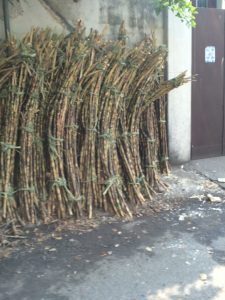
It is my total belief that my mum makes the best pongal ever. However if you’re looking for authentic south Indian recipes for these, check out this.
Tamils, the people of Tamil Nadu from the south of India, wherever they are in the world, whether they had migrated thousands of years ago or have emigrated recently, celebrate this festival.
The festival is celebrated over four days and is based on the assumption that most Tamils live in villages, work on the farms and they subsist through the land. Therefore the day after harvest, they have more expendable cash and time.
The first day is called Bhogi – the day the family gets ready for the festival. They get rid of old things and furnish their house with new things, paint their house and get ready for the festival. It did create an unhealthy habit of burning stuff on the streets which I’m told is no longer encouraged.
The second day is the celebration of the Pongal festival. With sugarcanes, milk and rice boiling in bronze pots and prayers to the sun god, this day is a wonderful celebration of hardwork and toil on the land especially in regions that do not have perennial rivers and the farmers live by chasing dark clouds of the monsoon.
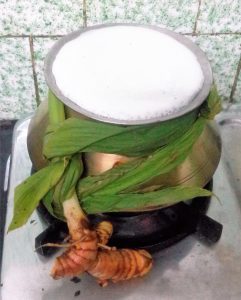 https://commons.wikimedia.org/wiki/Us...
https://commons.wikimedia.org/wiki/Us...The third day of the celebration is dedicated to the cattle that help the farmers on the farm. It’s called Mattu Pongal – and the bulls are washed and their horns decorated. In some parts of the state, a bull-chasing ceremony is organised. Extremely dangerous yet very characteristic of the culture for thousands of years, Jallikattu as it’s called, has come under modern scrutiny.
Now, that all festivities are done, it’s time to spend that money from the harvest. So the fourth day is celebrated as Kaannum Pongal, where people go on family outings to fairs, movies, seasides, parks etc. As India and especially Tamil Nadu is home to one of the biggest cinema industries in the world, this day marks the release of popular movies of the year too. This day families get together and enjoy spending time together. In our families, this is a day to honour and pray for siblings wherever they are, by offering coloured rice to the crows.
Farmer Falgu however is not from the south. He’s from Rajasthan and he too celebrates the harvest but differently. Being a farmer, the festival of Sankaranthi is extremely significant for him. In Rajasthan on the day of the outing, everyone flies kites and mark the day of the kite festival. It would be remiss not to celebrate a festival full of colour and joy and that’s what we’ve done in this book Farmer Falgu Goes Kite-Flying. Illustrated by Kanika Nair and published by Karadi Tales in India and the US, Red Robin Books in the UK, it’s the perfect book for little ones this harvest season. 